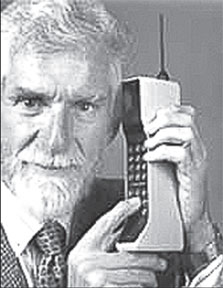Forty years of cellular telephony
 Can you believe that cellular telephony is now 40 years old? Last
Wednesday, a largely wireless world celebrated that major milestone in
human history. It was on April 3, 1972 that Martin Cooper of Motorola
made the first cellphone call 40 years ago. Can you believe that cellular telephony is now 40 years old? Last
Wednesday, a largely wireless world celebrated that major milestone in
human history. It was on April 3, 1972 that Martin Cooper of Motorola
made the first cellphone call 40 years ago.
The former Motorola vice president and division manager made the call
on the company's DynaTAC phone while standing near the New York Hilton.
His first call was to the head of research at Bell Labs, which had also
been racing to build the first cellphone.
It did take at least one more decade for the technology to be
commercially feasible and it was only around 1988-89 that the technology
really took off on a limited scale. Many of us do remember these
Motorola “brick” phones which were the only phones available then.
The cost, of course, was astronomical - a “brick” cost more than
Rs.100,000 and local cellular call rates were more expensive than a
typical IDD call would cost today.
(Motorola is now owned by Google, whose Android operating system is
used in most smartphones).
Today, more than six billion people around the world own a mobile
phone (the world’s population is only seven billion). At least one
billion of them are so-called smartphones with a wide variety of
functions, which probably have more computing power than NASA’s lunar
modules had in the 1960s.
Local and IDD call rates are ultra-cheap and so are the basic
handsets. You can take your phone around the world and still be
connected on the same number, credit can be topped up from anywhere in
the world and there is even no need to call at all give someone a
message. Just sending a text will do. That innovation came in 1992 and
today, nearly 250,000 texts are sent every second around the world. The
world’s six billion mobile subscribers sent a whopping eight trillion
texts last year.
 |
|
Martin Cooper with the
first cellular phone |
Perhaps the most astonishing change can be seen in the size of
phones. The DynaTac weighed over a kilo, but a typical phone weighs less
than 150 grams today, even with all the computing power. The screens
have been transformed into LED colour screens from the one-line number
displays of yesteryear.
Disguised
Some of the latest handsets virtually are powerful computers
disguised as phones.
The telephone call itself has become a victim of the cell phone’s
runaway success. Telephony has become the sixth or seventh most
important function for most people after texting, web browsing, email,
playing games, social networking, text-based chatting, diary and
organiser functions, watching TV and listening to the radio/MP3 music,
camera and video functions. In fact, the latest smartphones feature
cameras so good that they can easily rival point and shoot digital
cameras. Phones can also be used to purchase goods and transfer money -
two ways in which they can almost replace credit cards and leather
wallets.
Cellular technology is constantly evolving. The introduction of GSM
(Global System of Mobile Communications) was a landmark development,
because it enabled number information to be stored a Subscriber Identity
Module (SIM) card.
Thus the number was no longer tethered to a phone and you could
simply insert your SIM into another phone and use it. Being a global
system, it enabled users to “roam” in other countries and still use the
original number. (This is still expensive, but the advent of PC calling
systems such as Skype, which is also available on many phones, has made
cellular roaming somewhat redundant). Then came faster speeds, not so
much for voice, but for data transfer. Web pages load faster, Skype
chats are seamless and clearer, YouTube is silky smooth and file
transfer is a cinch with the latest 4G handsets. With most phones also
equipped with Wi Fi and Bluetooth, connectivity is ensured in a myriad
of ways.
Other technologies also helped ensure the cellphone’s success. The
DynaTac had a massive battery that was good for 20 minutes talk time and
took 10 hours to recharge.
Today’s small Li-ion batteries can last for a maximum of four weeks
and recharge in an hour. Microphones and earpieces have improved
tremendously. The DynaTac had 30 big circuit boards - most phones now
have a single small chip that does it all.
It is hard to predict what even the next few years will turn up in
terms of cellular telephony, leave alone the next 40 years. Cellular
carriers are looking beyond the handset - to connect everything from
cars to dog collars and medicine pill bottles.
Cellular companies believe that by 2017, there will be more than 10
billion mobile devices around the world (more than the world’s
population), with video accounting for 66 percent of all traffic.
Radiation
Like everything else, there are pros and cons of mobile phone usage.
Health concerns have been raised over radiation emanating from phones,
though there is no conclusive proof that they are actually harmful.
Some people seem to be addicted to their mobile phones, much to the
detriment of their family and social life.
This is worse when it comes to children and youth. There are many
instances when phone cameras are misused and pornographic videos are
circulated via mobiles. Drivers who use handsets while driving for
calling and texting risk injury and death.Similarly, most pedestrians
engrossed in phone conversations are oblivious to traffic conditions and
noises, which is really dangerous on busy roads.
If your phone containing private information is stolen and falls into
wrong hands, that could also be dangerous.
However, the pros far outweigh the cons. There are only a very few
places on Earth without a cellular signal - so-called “pico cells”
provide a cellular signal in the deepest of tunnels and even 10,000
metres up in the air.
Yes, that last place where cellular usage was forbidden - passenger
cabin of aircraft - has now been conquered with some airlines allowing
passengers to make calls using their own handsets after reaching
cruising altitude. There is no limit to cellular technology - engineers
are already working on next generation 5G systems. It is up to us to use
this remarkable technology intelligently and responsibly.
Indeed, as per Motorola’s motto of the good old days, cellular
telephony has spread “Intelligence Everywhere” and made the world a
well-connected place.
|


